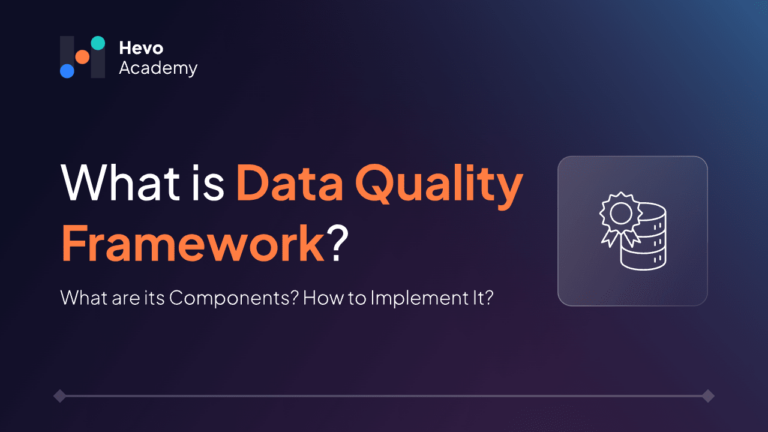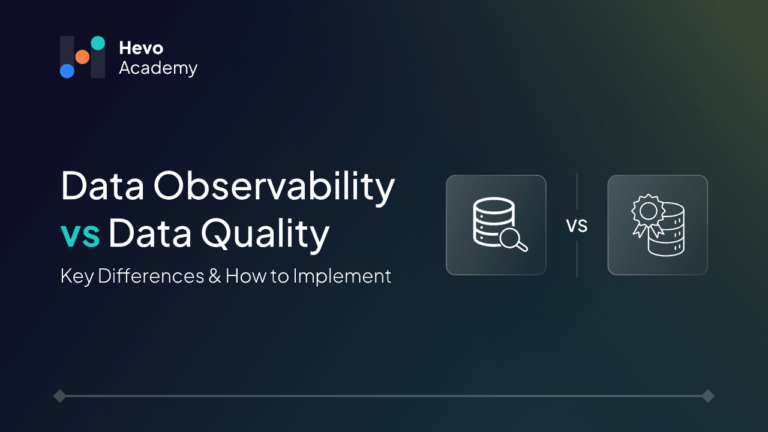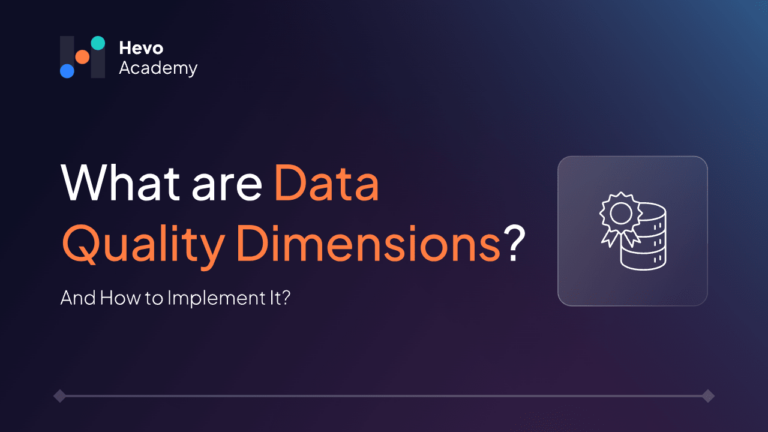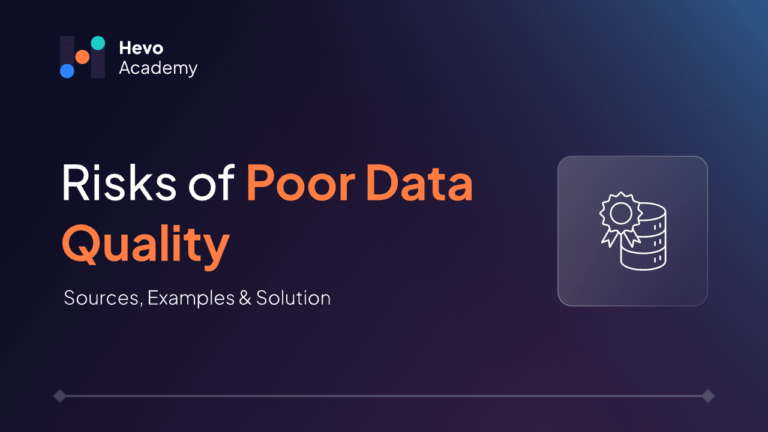In the modern data-driven world, businesses create and need large volumes of data to base informed decisions. According to IDC, by 2025, the global datasphere will have grown to 175 zettabytes. But, considering this data, quality is one of the most decisive factors. Poor quality data costs the average organization $12.9 million annually, according to a survey by Gartner. This raises the importance of a sound data quality framework. Since it would guarantee data accuracy, consistency, completeness, and reliability, it would be something of value within an organizational context.
Table of Contents
In this article, we will discuss the data quality framework and its role in keeping data sanity in check in any data-driven organization.
What is a Data Quality Framework?
A Data Quality Framework (DQF) is a structured set of standards, policies, processes, and technologies assisting organizations in making quality data assured. It provides a structured approach to measuring and observing data quality in multiple dimensions, including accuracy, completeness, timeliness, consistency, and validity. While laying out standards, the framework essentially provides a founding base on top of which one could govern the quality of the data and enable business operations with trustworthiness, operational efficacy, and decision-making.
Hevo ensures that your data transfers are secure and reliable, with no data loss. Experience end-to-end encryption for complete peace of mind.
- Zero Data Loss: Safeguard your data from source to destination.
- Complete Data Security: Enjoy encrypted transfers to protect your sensitive information.
- Efficient ETL/ELT: Process data in real-time without compromising security or performance.
Trust Hevo to handle your ETL/ELT needs with unparalleled efficiency and security.
Get Started with Hevo for FreeTo learn more about Data Quality:
- What is Data Quality Management?
- How to Improve Data Quality: Tips & Strategies
- Most Common Data Quality Issues
Key Components of a Data Quality Framework:
Data Profiling is the scanning of existing data for quality, to understand patterns, and to find possible flaws in the form of duplicate records, inconsistencies in data, or partial records. Customer records, for example, may be found to have no contact information or contain duplicate entries through data profiling.

Data Quality Metrics: These are set standards or benchmarks put in place to measure data quality. As an example, the accuracy of data metrics would include a rule specifying that 95% of records must match with source systems.
Data Governance: Good governance deals with well-defined roles and responsibilities, including rules about data stewardship. This makes departments responsible for data management.
Data cleansing and enrichment: It could be understood in a general sense as referring to the correction of errors in the data. Enrichment means the addition of more detail to the available data. A good example could be adding demographic information to customer profiles, thus making them more complete and worth more.
Monitoring and Reporting: A framework should provide for periodic monitoring of data quality using automated tools, coupled with periodic reporting of deviations from set standards.
What are the benefits of a Data Quality Framework?
Some of the key benefits of a Data Quality Framework will include:
Better Decision Making: High-quality data leads to more accurate insight, hence better business decisions. Retailers are great at predicting demand because their sales numbers are dependable.
Operational Efficiency: Clean, reliable data reduces manual intervention in a business. Therefore, all the business processes will be more streamlined-inventory management will be properly optimized with regards to stock levels.
Regulatory Compliance: The finance and health sectors are among the most regulated ones. Strong frameworks make such data compliant with myriads of regulations, such as GDPR or HIPAA.
Customer Satisfaction: Better quality of customer data ensures higher levels of service delivery since companies can offer services based on correct customer preference and history.
What are the Challenges of Data Quality Frameworks?
Data Silos: Most organizations face such problems wherein data are kept isolated among various departments or systems. This fragmentation aggravates the process of effective data governance and, therefore, affects data quality.
Resource Limitations: Time, budget, and skilled personnel are required for implementing such an overall framework; it may be scarce in the case of a smaller organization.
Complexity of Data Source: The more varied the sources like data from IoT devices, social networking sites, more third-party data the more complex it is to ensure the quality of that data coming in from disparate sources.
Evolution and Growth of Business Requirements: Organizations are ever-changing and expanding; hence, requirements on data quality continue to shift. Sometimes it is exhausting to keep pace with such demand changes; as a matter of fact, demands will always change, and sometimes the framework changes.
How to Implement Data Quality Frameworks
Start Small and Scale: First, implement the framework on a small-scale instance, within a department or a relatively small project then give them time to refine it before scaling.
Establish Clear Ownership of Data: Clearly define various data stewards responsible for the quality of data concerning their areas. This decentralizes responsibility while encouraging accountability.
Leverage Automation: Avail the facility of automated tools for data cleansing, profiling, and monitoring to reduce human errors and increase efficiency. In this respect, machine learning-based data quality tools can automatically detect anomalies and make recommendations for fixes.
Foster a Data Quality Culture: Drive organizational-wide focus on data quality by training and creating awareness. This includes being an advocate for the importance of data quality across all departments and activities so that everyone involves themselves in it.
Common Data Quality Framework:
Various frameworks of data quality have been put forward to assist organizations in understanding, managing, and improving their data quality. Let us discuss some of the popular frameworks in brief:
- Data Quality Assessment Framework-DQAF
The International Monetary Fund developed the Data Quality Assessment Framework, a framework that focuses on statistical data. It provides a conceptual framework for data quality assessment based on five key dimensions of data quality, including:- Assurances of Integrity: This assessment includes the credibility and reliability of the sources providing the data.
- Methodological Soundness: Checks if the methodologies applied to collect data are appropriate and scientifically valid.
- Dimension of Accuracy and Reliability: Closeness of data to reality, consistency over time.
- Serviceability: This refers to the timeliness and periodicity of releases.
- Accessibility: This reflects how users can access data and related metadata easily.
The above framework is useful for policymakers, researchers, and users of data since it gives a clear guide on the basis on which to evaluate data against internationally accepted standards.
- Total Data Quality Management-TDQM
Total Data Quality Management (TDQM) is a holistic approach to the management of data quality created by Richard Y. Wang at MIT. Unlike other frameworks that define certain fixed dimensions, TDQM focuses on four stages: definition, measurement, analysis, and improvement.
In other words, defining means to determine what quality data means to the organization. Measuring involves quantifying the existing state based on predefined metrics. Analyzing provides the root causes of data quality problems in detail. Finally, improving involves strategies toward continuously enhancing the quality of data.
TDQM emphasizes stakeholder participation through all layers of the organization and can be executed with various kinds of data and various organizational needs. It does, however, require a possibly high amount of resources and/or the high education of staff in the whole data life cycle.
- Data Quality Scorecard
The Data Quality Scorecard is flexible and provides an organization with an enabling methodology to capture the data quality metrics against pre-defined metrics relevant to organizational needs. No single origin or developer exists, but management consultants adapted variants of the methodologies.- Customizable Metrics: Organizations can define their metrics based on critical business needs.
- Visualization: The scorecard format allows for clear visualization of data quality performance over time.
- Benchmarking: Organizations can benchmark scores against generally accepted standards in the industry or their internal standards.
The DQS approach enables an organization to spot areas that need improvement in the quickest possible time and thus instills responsibility in teams at regular intervals to maintain good quality data.
- Data Quality Maturity Model (DQMM)
The Data Quality Maturity Model offers a structured path that guides organizations in improving data quality. It describes the stages of maturity an organization might pass through. Data model lays the groundwork for improving data quality maturity. Levels of maturity commonly include the following: Initial – processes are ad hoc; there is little awareness of data quality issues; Managed – basic processes exist but are not standardized; Defined – policies and procedures for data quality management are established.- Quantitatively Managed: The processes are managed by metrics and continuously improved.
- Optimizing: Continuous process improvement is established, along with an emphasis on innovation.
Some of the variants that fall into this category include but are not limited to, Capability Maturity Model Integration, and Data Management Maturity Model provides a different insight into improving the overall methodology of data management for a company.
Conclusion
In the era of data-driven processes, data quality cannot be taken for granted. A well-designed Data Quality Framework leads an organization through work processes and standards for high-quality data that ensures better decision-making, operational efficiency, and compliance. Of course, there are challenges ahead, but those can be conquered with the proper strategies and frameworks in place, so data will continue to be a core asset and not a liability. As data continues to grow in importance, it will be of paramount importance to make prudent investments in a robust Data Quality Framework for long-term success.
Sign up for a 14-day free trial and experience the feature-rich Hevo suite first hand. Check out the Hevo pricing details.
Frequently Asked Questions on Data Quality Framework
What are the 5 dimensions of a data quality framework?
Accuracy, completeness, consistency, timeliness, and validity are the five dimensions of a data quality framework
What are the 7 C’s of data quality?
Completeness, consistency, correctness, clarity, credibility, coherence, and conformity are the 7 C’s of data quality.
What is the five dimensions framework?
The five dimensions framework usually refers to a model assessing data across Accuracy, Completeness, Consistency, Timeliness, and Validity.





